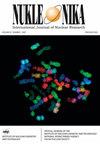康普顿背散射壁缺陷检测装置的蒙特卡罗方法研究
IF 0.3
4区 物理与天体物理
Q4 CHEMISTRY, INORGANIC & NUCLEAR
引用次数: 0
摘要
摘要针对传统墙体缺陷检测方法检测范围小、精度差、设备不便携等缺点,采用蒙特卡罗方法设计了一种基于康普顿后向散射技术的墙体缺陷检测装置,主要用于检测混凝土墙体缺陷的尺寸和位置信息。主要由源容器和检测系统两部分组成:首先,通过对后向散射粒子的接收角度和探测器后准直材料等参数的仿真分析,消除了探测器准直材料的荧光x射线峰对后向散射粒子数的影响,减小了检测误差;其次,环形阵列探测器设计,与单阵列探测器和面阵列探测器相比,可以方便实时检测缺陷方位,扩大单次扫描范围,提高检测效率。通过仿真和对比分析,得到了相应的优化参数:利用活度为6 mCi的Cs-137 γ射线源对目标进行探测,在150°位置放置由4个0.5英寸立方体CsI闪烁体探测器组成的环形探测器接收后向散射光子。利用蒙特卡罗FLUKA程序进行仿真分析,结果表明:墙体缺陷检测的最大深度为8 cm,缺陷深度和厚度的最大误差波动范围为±1 cm,整机重量<20 kg,测量时间<5 min。本文章由计算机程序翻译,如有差异,请以英文原文为准。
Study of a Compton backscattering wall defects detection device using the Monte Carlo method
Abstract In view of the shortcomings of traditional wall defect detection methods, such as small detection range, poor accuracy, non-portable device, and so on, a wall defects detection device based on Compton backscattering technology is designed by Monte Carlo method, which is mainly used to detect the size and location information of defects in concrete walls. It mainly consists of two parts, the source container and the detection system: first, through the simulation and analysis of the parameters such as the receiving angle of the backscattered particles and the rear collimating material of the detector, the influence of the fluorescent X-ray peak of the detector collimating material on the backscattered particle counts is eliminated and the detected error is reduced; second, the ring array detector design, compared with single array detector and surface array detector, can facilitate real-time detection of defect orientation, expanding the single scan range and improving the detection efficiency. After simulation and comparative analysis, the relevant optimal parameters are obtained: the object is detected using a Cs-137 γ-ray source with an activity of 6 mCi, and a ring detector consisting of four 0.5-inch cube-shaped CsI scintillator detectors is placed at 150° to receive the backscattered photons. The simulation analysis using the Monte Carlo FLUKA program showed that the maximum depth of wall defect detection is 8 cm, the maximum error fluctuation range of defect depth and thickness is ±1 cm, the overall device weight is <20 kg, and the measurement time is <5 min.
求助全文
通过发布文献求助,成功后即可免费获取论文全文。
去求助
来源期刊

Nukleonika
物理-无机化学与核化学
CiteScore
2.00
自引率
0.00%
发文量
5
审稿时长
4-8 weeks
期刊介绍:
"Nukleonika" is an international peer-reviewed, scientific journal publishing original top quality papers on fundamental, experimental, applied and theoretical aspects of nuclear sciences.
The fields of research include:
radiochemistry, radiation measurements, application of radionuclides in various branches of science and technology, chemistry of f-block elements, radiation chemistry, radiation physics, activation analysis, nuclear medicine, radiobiology, radiation safety, nuclear industrial electronics, environmental protection, radioactive wastes, nuclear technologies in material and process engineering, radioisotope diagnostic methods of engineering objects, nuclear physics, nuclear reactors and nuclear power, reactor physics, nuclear safety, fuel cycle, reactor calculations, nuclear chemical engineering, nuclear fusion, plasma physics etc.
 求助内容:
求助内容: 应助结果提醒方式:
应助结果提醒方式:


